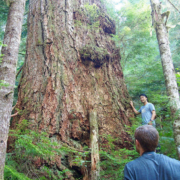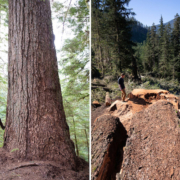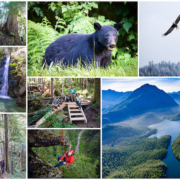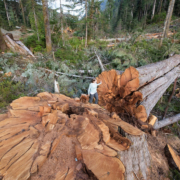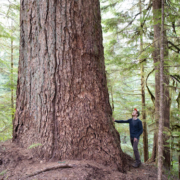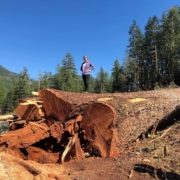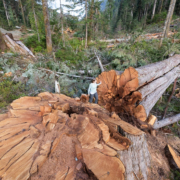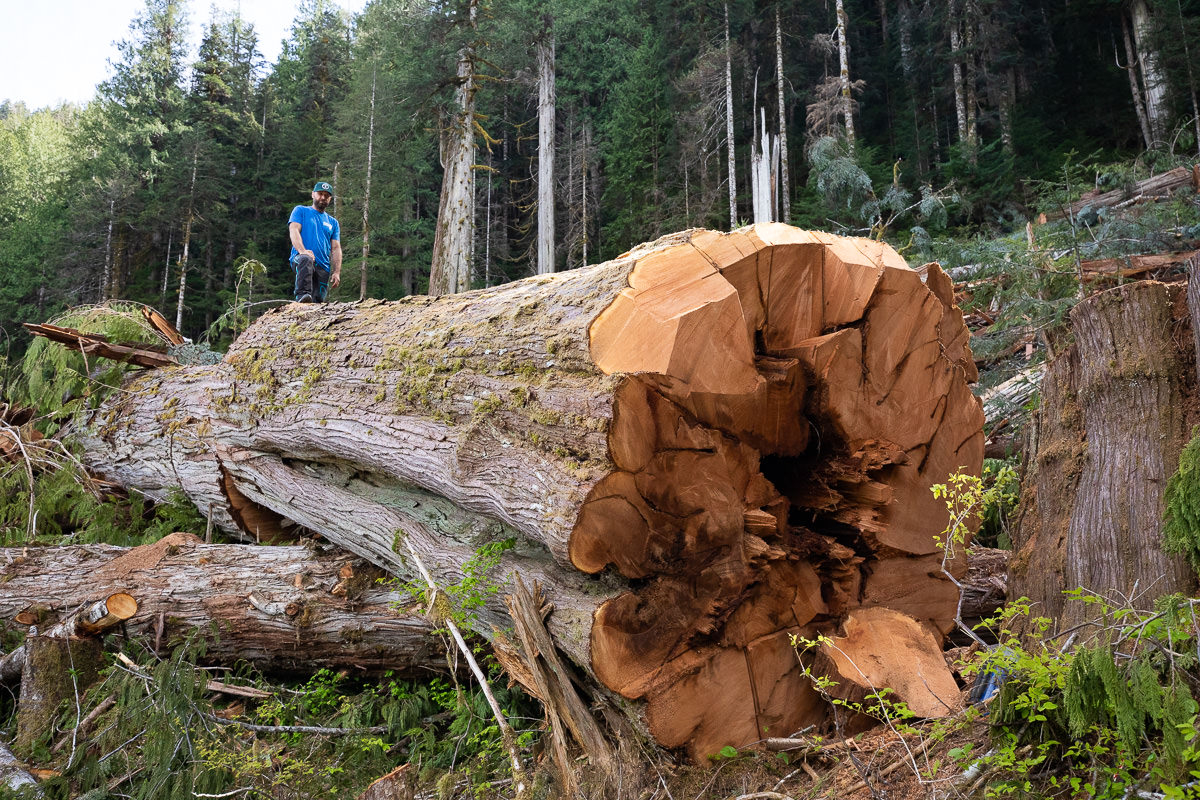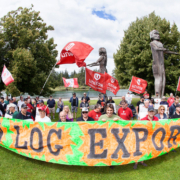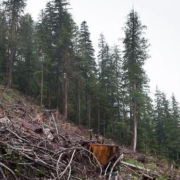For Immediate Release
Ancient Forest Alliance campaigners were dismayed to discover that Canada’s ninth-widest Douglas-fir tree (compared to the trees listed on the BC Big Tree Registry) was cut down last week. The massive tree, which stood 66 metres (216 feet) tall and 3.0 metres (10 feet) in diameter, was located in the Nahmint Valley near Port Alberni and had only just been found by the group earlier this month, standing within a planned cutblock auctioned off by the BC government’s logging agency, BC Timber Sales. Two weeks after first finding the tree in early May, conservationists returned to find the colossal tree had been felled.
Thousands of old-growth trees are being logged in over 300 hectares of cutblocks issued by BC Timber Sales (BCTS) in the Nahmint Valley. The 300 hectares constitute some of the very grandest remaining “monumental” stands of “high productivity” old-growth forests (i.e. the largest trees on the best growing sites) left in the valley. Most of the Nahmint Valley’s monumental groves, growing at lower elevations, have long since been logged and much of the remaining old-growth forests outside of these cutblocks are comprised of much smaller trees growing on low and medium productivity sites, including much of the 2700 hectares forests currently reserved in Old-Growth Management Areas and other forest reserves. Environmentalists are now redoubling their efforts to pressure the BC government to direct their logging agency to stop issuing old-growth cutblocks in BC, to implement a Big Tree Protection Order to protect BC’s biggest trees (including buffer zones) and grandest groves, and most importantly, to develop comprehensive, science-based legislation to protect endangered old-growth forest ecosystems across the province while ensuring a sustainable, value-added, second-growth forest industry. The Nahmint Valley contains some of the most extensive remaining stands of old-growth forests on Vancouver Island outside of Clayoquot Sound and is in the territory of the Hupacasath and Tseshaht First Nations bands.
“We’d seen this magnificent Douglas-fir, towering above its neighbours in the forest earlier in May and decided to take a measurement. We couldn’t believe we’d found the ninth-widest Douglas-fir in the country,” stated Mike Stini of the Port Alberni Watershed-Forest Alliance. “To see it lying on the ground two weeks later was devastating, especially since these big, old Douglas-firs are now endangered after a century of commercial logging. There are less than 1% of the old-growth Douglas-firs on the coast remaining. It’s like finding a huge black rhino or Siberian tiger that’s been shot. There are simply too few today and logging the last of these giants shouldn’t be allowed to happen anymore in BC,” stated Stini.
“According to BCTS’ policy, Douglas-fir trees over 2.1 meters (7 feet) wide and western redcedars over 3 metres (10 feet) wide located within BCTS-issued cutblocks should be left standing,” stated Ancient Forest Alliance campaigner TJ Watt. “In spite of this policy, they still cut down Canada’s 9th widest Douglas-fir tree that was 3 meters (10 feet) wide – far larger than their minimum protection size – and we saw several fresh cedar stumps wider than 3 metres. In addition to it being a weak policy to begin with, with plenty of loopholes and lacking buffer zones for the biggest trees, they aren’t even implementing it in the Nahmint Valley. BCTS’ ‘best practices’ didn’t even save the ninth-widest Douglas-fir in Canada.”
BC Timber Sales in January launched their big tree protection policy, the Best Management Practices for Coastal Legacy Trees initiative, to protect the largest trees over a minimum diameter size in BCTS-issued cutblocks. The policy fails to include mandatory buffer zones (creating more “Big Lonely Doug” scenarios where the largest Douglas-firs and redcedars stand alone in clearcuts) and has many loopholes (such as allowing the largest trees to be cut if they block access for logging or if the government deems that there are enough large trees already protected in the area). Despite the policy being in place, the Ancient Forest Alliance (AFA) and local conservationists found freshly logged western redcedar and Douglas-fir trees throughout the valley – including Canada’s ninth-widest Douglas-fir – that exceeded the minimum protection sizes set out in the policy.
“Although it should be a no-brainer to protect BC’s biggest trees, what we ultimately need is protection for endangered forest ecosystems, which are under siege by commercial logging. Almost 11,000 hectares of old-growth forests were cut on Vancouver Island in 2016,” stated Ancient Forest Alliacne campaigner Andrea Inness. “And where better to start protecting old-growth than at the government’s own logging agency, BC Timber Sales?”
“It’s incredibly disappointing that the BC government has a deficient policy for big tree protection – which they aren’t even implementing – on BC Timber Sales managed lands where they directly plan logging and that they are dragging their heels on implementing a similar policy on other Crown lands,” stated TJ Watt. “We have been calling on the province to implement a Big Tree Protection Order to save BC’s last remaining big trees with buffer zones and smaller minimum protection sizes, but monumental trees continue to be cut while we wait for the NDP government to take action. Most importantly, we need old-growth ecosystems protected on a much larger scale, and a value-added, sustainable second-growth forest industry, which will require a far larger overhaul of BC’s unsustainable forest policies. If the BC government is showing itself to be incompetent in protecting the very largest trees in the province, this does not bode well for the necessary protections of forest ecosystems and tens of thousands of forestry jobs dependent on sustainable policies.”
The BC government began developing the Big Tree Protection policy in 2011 and, according to the Ministry of Forests, the policy is still under development and won’t be officially implemented for another year or two.
“We’ve been in liaising with the new government and Ministry of Forests since July last year and have put forward a suite of forest policy recommendations that the BC government can implement over both short- and long-term timeframes. In addition to a comprehensive, science-based law to protect endangered old-growth forests, one of the recommendations is for the BC government to direct BC Timber Sales to discontinue the issuance of old-growth cutblocks. They have declined to do so thus far,” stated Inness.
BC Timber Sales (BCTS), a division of the Ministry of Forests, Lands, Natural Resource Operations and Rural Development, is the BC government’s logging agency that plans and directly issues logging permits for about 20 per cent of the province’s merchantable timber on Crown lands, which fall outside of forestry tenures. The BC government retains full control over which cut blocks are auctioned each year through BCTS and can therefore use this control to quickly phase out issuing timber sales in old-growth forests in these areas.
The Ancient Forest Alliance, along with conservationists from Sierra Club BC and Wilderness Committee, have also met with Minister of Forests Doug Donaldson and key ministry staff to highlight the urgency of BC’s old-growth forest crisis and provide a map of old-growth ‘hotspots’ – areas of high conservation and recreational value that warrant immediate protection.
“For almost a year now, the NDP has been dragging its heels, giving excuses, and plodding along with the destructive status quo of high-grade old-growth forest liquidation, raw log exports, mill closures, and unsustainable forestry in general. It’s obvious they feel no sense of urgency to act,” stated Ancient Forest Alliance executive director Ken Wu.
“The NDP needs to wake up and break away from the old, unsustainable mindset that has driven the increasing collapse of both ecosystems and rural communities in this province,” said Wu. “Today, there’s a viable, potentially sustainable, second-growth forestry alternative that the government can foster through regulations and incentives while protecting endangered old-growth forests and supporting the economic diversification of First Nations and rural communities. So far it has only been the Green Party advocating major old-growth forest protection and a forest policy overhaul.”
The Nahmint Valley is considered a “hotspot” of high-conservation value old-growth forest by conservation groups, with some of the largest tracts of remaining old-growth forests on Vancouver Island outside of Clayoquot Sound, and is home to Roosevelt elk, black-tailed deer, cougars, wolves, and black bears, as well as old-growth associated species like the marbled murrelet and northern goshawk. The area also supports significant salmon and steelhead spawning runs. The Nahmint is considered by many people to be one of the most scenic areas in BC, with its ancient forests, rugged peaks, gorgeous turquoise canyons and swimming holes, and large and small lakes, and is heavily used by hikers, campers, anglers, and hunters.
More Background Info
Old-growth forests are vital to sustaining unique endangered species, climate stability, tourism, clean water, wild salmon, and the cultures of many First Nations. On BC’s southern coast, satellite photos show that at least 75% of the original, productive old-growth forests have been logged, including well over 90% of the valley bottoms where the largest trees grow. Only about 8% of Vancouver Island’s original, productive old-growth forests are protected in parks and Old-Growth Management Areas. Old-growth forests – with trees that can be 2000 years old – are a non-renewable resource under BC’s system of forestry, where second-growth forests are re-logged every 50 to 100 years, never to become old-growth again.
On BC’s southern coast (Vancouver Island and the southwest mainland), 75% of the original, productive old-growth forests have already been logged, including over 90% of the valley bottoms where the largest trees grow. 3.3 million hectares of productive old-growth forests once stood on the southern coast (with an additional 2.2 million hectares of bog, subalpine forests, and other low productivity old-growth forests of low to no commercial value with stunted trees), and today only 860,000 hectares remain, while only 260,000 hectares are protected in parks and Old-Growth Management Areas. Second-growth forests now dominate 75% of the southern coast’s productive forest lands, including 90% of southern Vancouver Island, and can be sustainably logged to support the forest industry. See “before and after” maps and stats of the southern coast’s old-growth forests at: www.ancientforestalliance.org/old-growth-maps.php
In order to placate public fears about the loss of BC’s endangered old-growth forests, the government’s PR-spin typically over-inflates the amount of remaining old-growth forests by including hundreds of thousands of hectares of marginal, low productivity forests growing in bogs and at high elevations with small, stunted trees, together with the productive old-growth forests where the large trees grow (and where most logging takes place). They also leave out vast areas of largely overcut private managed forest lands – previously managed as if they were Crown lands for decades and still managed by the province under weaker Private Managed Forest Lands regulations – in order to reduce the basal area for calculating how much old-growth forest remains, thereby increasing the fraction of remaining old-growth forests. See a rebuttal to some of the BC government’s PR-spin and stats about old-growth forests towards the BOTTOM of the webpage: https://16.52.162.165/action-alert-speak-up-for-ancient-forests-to-the-union-of-bc-municipalities-ubcm/
In recent times in BC, the voices for old-growth protection have been quickly expanding, including numerous Chambers of Commerce, mayors and city councils, forestry unions, and conservation groups across BC who have been calling on the provincial government to expand protection for BC’s remaining old-growth forests.
BC’s premier business lobby, the BC Chamber of Commerce, representing 36,000 businesses, passed a resolution in May of 2016 calling on the province to expand protection for BC’s old-growth forests to support the economy, after a series of similar resolutions passed by the Port Renfrew, Sooke, and WestShore Chambers of Commerce. See: https://16.52.162.165/media-release-historic-leap-for-old-growth-forests-bc-chamber-of-commerce-passes-resolution-for-expanded-protection/
Both the Union of BC Municipalities (UBCM), representing the mayors, city and town councils, and regional districts across BC, and Association of Vancouver Island and Coastal Communities (AVICC), representing Vancouver Island local governments, passed a resolution in 2016 calling on the province to protect the Vancouver Island’s remaining old-growth forests by amending the 1994 land use plan. See: https://16.52.162.165/media-release-ubcm-passes-old-growth-protection-resolution/
The Public and Private Workers of Canada (PPWC), formerly the Pulp, Paper, and Woodworkers of Canada, representing thousands of sawmill and pulp mill workers across BC, passed a resolution in 2017 calling for an end to old-growth logging on Vancouver Island. See: https://16.52.162.165/conservationists-applaud-old-growth-protection-resolution-by-major-bc-forestry-union/
Each year, a significant portion of the provincial timber harvest is carried out on BC Timber Sales (BCTS) controlled land through its timber sales program. BCTS, a division of the Ministry of Forests, Lands, Natural Resource Operations and Rural Development (FLNRO), is the BC government’s logging agency that plans and directly issues logging permits for about 20 percent of the province’s merchantable timber on Crown lands, which fall outside of forestry tenures. Under this system, logging rights are granted through competitive auction to the highest bidding company for each timber sale, which provides benchmark costs and prices from the harvest of Crown timber in BC in order to set stumpage rates for tenure holders. The remaining 80 per cent of the province’s annual timber harvest occurs under the timber tenure system through tree farm or forest licences within Timber Supply Areas, woodlot licences, First Nations woodland licences, community forest agreements, or other tenures.
As the BC government retains full control over which cut blocks are auctioned each year through BCTS, the new government should use this control to quickly phase out issuing timber sales in old-growth forests and support implementation of conservation steps.

